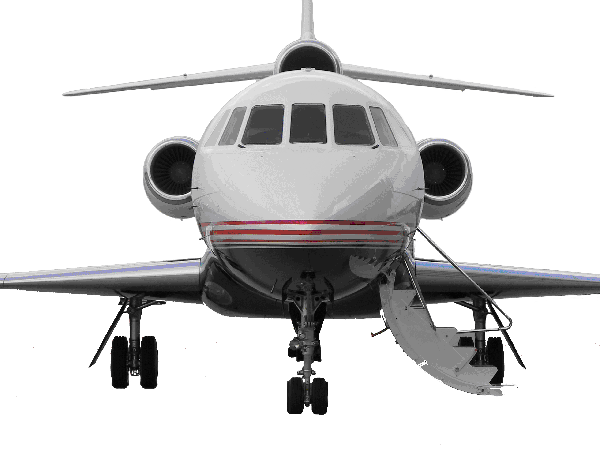
 |
John W Beck, PhD |
 Aegean Sea in the Mediterranean
We departed Newark, New Jersey on Saturday 6 June and flew to Athens, Greece
where we boarded our Atlantic 61 sloop for two weeks of sailing in the
Cyclades Islands southeast of Athens. Our ten person crew consisted of seven
experienced sailors, three boat owners, one boat mechanic, and an ASA
instructor captain. The weather was perfect each day with clear skies and
warm temperatures. The first week winds were excellent as we visited Kea,
Mykonos, and Delos though unable to sail due to boat problems. After a full
day in Mykonos on the town quay repairing the sail, batteries, windlass,
dinghy engine, and clogged plumbing, we departed for Paros where we took the
ferry to Santorini. We visited the ancient ruins, small cliff-side villages,
black-sand beaches, and a winery. Upon returning to Paros we spent the day
exploring the beaches and shopped in the little towns discovering excellent
pottery along the road. Our sail to Sifnos was most excellent as we enjoyed
a 15 knot wind and were able to sail at 7 knots. The Atlantic 61 is an
excellent sailing vessel. The anchorage at Vathi on Sifnos was a favorite -
secluded, beautiful, and the home of a most excellent potter. We hiked and
hitched to town where we continued our exploration and were able to get bus
and taxi rides. We motored to Loutra on Kythnos where we moored stern-to the
quay. We motored back to Athens where we spent a day sight-seeing. Our final
"goodbye" from Creta,our boat, came with a plume of black smoke
and oil spewing forth into the harbor as one of our many fears came true - a
blown head gasket (we think). We left the yacht for a couple days of peace
and tranquillity Athens' "Plaka" and had a most enjoyable visit.
|
||||||||||||||||||||||||||
| Destination | Dist |
| Vourkari, Kea | 37 |
| Ornos, Mykonos | 55 |
| Paroikia, Paros | 26 |
| Vathi, Sifnos | 30 |
| Loutra, Kythnos | 37 |
| Kalamaki, Athens | 47 |
Navigation is important as there are a few hazards to be avoided. A typical day was 85 degrees with sunny skies though it got quite hot the last few days we were there. Athens newspapers reported a record heat wave on Thursday with 100 people being hospitalized in the city for heat related medical problems.
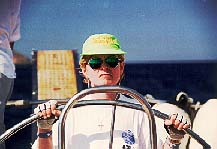 We departed Kalamaki Marina (37° 54.72' N, 23° 42.29' E) at
12:45 pm. Lots of boat chores to get ready.
The sky was clear and wind 030° at 8-10 knots with seas 2 feet. We set the
main and motor sailed. At 2 pm the wind increased to 20 knots and our
velocity made good under sail was 7.5 knots. At 2:15 we reefed the main and
the Genoa. By 2:30 the wind was 18 to 20 knots and we were making 6.7 knots.
The mountains of Athens made some wind gusts that were strong in places. We
were heading southeast and then east. At 3:30 the wind increased to 24 knots
and we soon attempted to take in more main as our rail was in the water. The
main was stuck with 2 wraps around the furling. We could neither get it in
nor out. At 4:30 pm the wind increased to 26 knots and approached 30 knots
in some places. The seas were 3-5 feet and the wind continued to gust in
excess of 30 knots. We tried tacking and jibing to furl the main and by 7 pm
the wind had eased to 16 knots and we were able to grind hard on the winches
to get the main in though the furling line had a big fray in it.
We departed Kalamaki Marina (37° 54.72' N, 23° 42.29' E) at
12:45 pm. Lots of boat chores to get ready.
The sky was clear and wind 030° at 8-10 knots with seas 2 feet. We set the
main and motor sailed. At 2 pm the wind increased to 20 knots and our
velocity made good under sail was 7.5 knots. At 2:15 we reefed the main and
the Genoa. By 2:30 the wind was 18 to 20 knots and we were making 6.7 knots.
The mountains of Athens made some wind gusts that were strong in places. We
were heading southeast and then east. At 3:30 the wind increased to 24 knots
and we soon attempted to take in more main as our rail was in the water. The
main was stuck with 2 wraps around the furling. We could neither get it in
nor out. At 4:30 pm the wind increased to 26 knots and approached 30 knots
in some places. The seas were 3-5 feet and the wind continued to gust in
excess of 30 knots. We tried tacking and jibing to furl the main and by 7 pm
the wind had eased to 16 knots and we were able to grind hard on the winches
to get the main in though the furling line had a big fray in it.
We docked stern-to the quay at Vourkari. The anchor deployed easily and the bow thrusters were very helpful. The anchor control at the helm worked fine though it would be much easier with a hand control at the bow. We took a short walk along the waterfront and got ready for dinner ashore. The hydraulic gangway was a big hoot and we walked off the stern of your boat into a restaurant on the dock. Appetizers were shared and our first authentic Greek meal was enjoyed by our entire crew. My most excellent meal cost only $8. After dinner we enjoyed a few shots of Ouzo aboard.
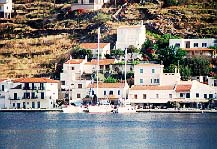
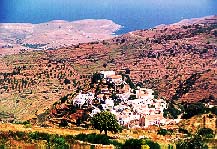 We
enjoyed the Vourkari Waterfront where we were docked at
Kea. There were restaurants lined up on the quay with a small store at one
end. The bus to town made its rounds a few times a day. Everyone on the quay
were very friendly and helpful.
We
enjoyed the Vourkari Waterfront where we were docked at
Kea. There were restaurants lined up on the quay with a small store at one
end. The bus to town made its rounds a few times a day. Everyone on the quay
were very friendly and helpful.
We planned to explore Chora, the capital of Kea. The skies were sunny with a pleasant 18kt wind from the northeast. After taking on water and eating breakfast, we took the 10 am bus to town. The Kastro quarter of town occupies the site of ancient Ioulis' acropolis and medieval walls though all that is left are stone blocks from the original temple of Apollo. The village had little to do with tourists though there were a few souvenir shops. Some of us hiked through the village and up a hill for panoramic photographs while others went in search of a famous petrified lion statue. This ancient guardian lion was chiseled from rock and stands 3 meters by 6 meters long. Other attractions include the majestic Hellenistic tower at the ruined monastery of Ayia Marina, beautiful beaches near the island's villages, and ancient Karthaea - a school of poetry. Upon returning to the village, we met for lunch in a local restaurant that was very good and inexpensive. A few mansions remain intact around Kastro and several churches date back to the Byzantine era.
We caught the 2 pm bus back to the boat where some explored the waterfront and others worked on the boat. That night we cooked pasta aboard and drank Ouzo after dinner. We went to bed at about midnight. Kea is fun and a quiet little place with little to do. It has a charm of its own. However, by now we were overwhelmed with boat problems and decided to seek help in Mykonos as no boat mechanic could be found in Kea.
Kea is a favorite place for summer villas because the island is the closest of the Cyclades to Athens. It can be reached by ferry in less than four hours. It receives a lot of water and is well known for its delicious red wine, lemons, honey, and almonds. The beaches are beautiful and the touristy spots are busy on the weekends. Kea is unhurried and free from commercial development. It has a history as a fishing settlement as early as 3000 BC. More recently (1916), the hospital ship Britannic, sister ship to the Titanic, sank 3 miles off shore after an explosion. Only 21 of the thousand people aboard lost their lives when their lifeboat capsized.
Kea's port Korissia has become a resort and is called Livadi by the locals. Shops and restaurants line the waterfront. In the same protected bay, Nikolaou Bay, Vourkari is both a fishing village and a popular place for private yachts to anchor and dock. Within a short walk there are excavations of the Bronze Age Minoan-Myceaean settlement. There are ruins of a temple, palace-type hall, and walls and streets clearly demarcated.
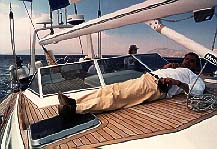 We departed Vourkari, Kea at 9:30 a.m. for Mykonos estimating
our arrival at 6 pm. The wind was 360° variable to 060 ° at 3 to 20 knots
with seas 2 to 4 feet. We motored with the jib when the wind favored it. The
main sail was unusable. We averaged 7 knots over the bottom. As the day
progressed, the wind become more favorable and we were disappointed our
second day at sea required the motor. Half way to our destination we checked
the oil level in the diesel as we were uncomfortable with the oil
consumption. It was below the bottom of the dip stick which now gave us
serious concern as our sails were not fully functional and our engine was
consuming an unusual amount of oil. We continued on arriving at Ornos Bay on
Mykonos by 5:30 pm. We anchored in 10 meters of water with 60 meters of
chain deployed. It was nice having 100 meters of chain and a big windlass.
We planned for a relaxing evening aboard before we headed to shore for
dinner though we had difficulty getting our generator started and the
refrigerator was not working.
We departed Vourkari, Kea at 9:30 a.m. for Mykonos estimating
our arrival at 6 pm. The wind was 360° variable to 060 ° at 3 to 20 knots
with seas 2 to 4 feet. We motored with the jib when the wind favored it. The
main sail was unusable. We averaged 7 knots over the bottom. As the day
progressed, the wind become more favorable and we were disappointed our
second day at sea required the motor. Half way to our destination we checked
the oil level in the diesel as we were uncomfortable with the oil
consumption. It was below the bottom of the dip stick which now gave us
serious concern as our sails were not fully functional and our engine was
consuming an unusual amount of oil. We continued on arriving at Ornos Bay on
Mykonos by 5:30 pm. We anchored in 10 meters of water with 60 meters of
chain deployed. It was nice having 100 meters of chain and a big windlass.
We planned for a relaxing evening aboard before we headed to shore for
dinner though we had difficulty getting our generator started and the
refrigerator was not working.
After some trouble shooting, we decided to check the oil level in the generator though we were assured that it would not require service and was very reliable. We were not surprised to find no oil in the generator and we added 3 liters of oil which solve the problem, we thought. The generator needed no additional oil over the next several days confirming our suspicion that the boat was inadequately maintained. The oil in the generator was very black and in dire need of changing (after we added 3 liters of oil). We decided to run the generator a minimum amount of time which was a bit inconvenient since the electric stove and all other systems required 220 volts from the generator. We continued to trouble shoot the refrigerator and freezer. Prior to departing for dinner we thought to check the bilge to be sure that the pumps were working only to find it flooded with oily sludge and the battery bank (6 large marine batteries) had slid off their shelf into the scum. We carefully tied lines to the batteries and hoisted the bank back to the battery shelf and pumped the bilge which left our boat surrounded by a surface layer of oil in the beautiful pristine bay. We re-crimped wires that had pulled free and planned to get electrolyte to replace the lost fluid and baking soda to neutralize the acid. We started the generator and the refrigerator worked for a little while.
We went to shore for dinner and four of us rented a car. Doug rented a moped though he crashed it on his way to town as there were mechanical difficulties. He returned it for a better one. Mopeds are very inexpensive to rent compared with cars. A car may cost $40-$50 for a day while a moped only costs about $10 per day including gas. The others took a bus to town and we met by a church on the town quay. I called Simon (we had called many times) and he directed us to contact Nikitas in a yellow van with "Sail Repair" on the side. Our dinner was most excellent in an authentic Greek restaurant (okay, all our dinners were really cool and very inexpensive). We shared appetizers for dinner. We headed back to the boat arriving before midnight. The crew and I were all very dissatisfied with the boat as we had spent a significant amount of time repairing it and missing excellent sailing winds.
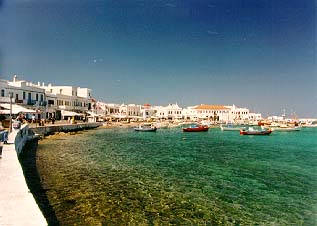
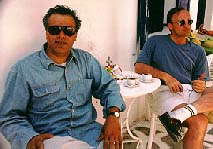 Everyone
was on their own to explore Mykonos. Four of us went to
town to find Nikitas and left the dinghy with the others. It was difficult
to start and now we had totally lost the engine so we paddled to shore (no
oars, just paddles). At 9 a.m. we found Nikitas at the quay and he said he'd
meet us at Ornos at 3 pm. We ate breakfast and shopped in town until noon.
Everyone
was on their own to explore Mykonos. Four of us went to
town to find Nikitas and left the dinghy with the others. It was difficult
to start and now we had totally lost the engine so we paddled to shore (no
oars, just paddles). At 9 a.m. we found Nikitas at the quay and he said he'd
meet us at Ornos at 3 pm. We ate breakfast and shopped in town until noon.
In the early afternoon we did a road trip to the northern lighthouse and then to the eastern shore. It was time to visit the most beautiful beaches but we had to head back to Ornos Bay to meet Nikitas at 3 pm. Half the crew had gone to the beach and planned to eat dinner in town. George and Hossein were waiting for us to get a ride back to the boat. We planned to have dinner in town though we did not have any rendezvous plans.
Mykonos is a dry, barren island graced with excellent beaches and a colorful cosmopolitan town with great night life. Because of this, it may be the most popular island in the Cyclades. The ancient cultures on Delos provides a major attraction to the tourist. Mykonos streets are packed with some of the zaniest, wildest, raunchiest, and most beautiful people in Greece. It is one of the most expensive islands and the first to sanction nudism on some of its beaches. The island is rich in both mythology and history. The island's picture-postcard capital and port is well maintained - gleaming white buildings with brightly painted wooden trim. The pelican mascot of Mykonos may be found wandering the streets of town. Small shops help support the local artists and a wide variety of souvenirs. Mykonos claims to have 400 churches. The best attractions in town include a Folklore Museum, Archaeology Museum, and Nautical Museum. The island attractions include the Tourliani Monastery, ancient cities, and the Garden of Rapaki. Paradise beach is a most beautiful beach and allows naked bathers. Ornos bay is well known for their selection of tavernas serving fresh fish. The night life in town is great fun!
Delos was the holy island of the ancient Greeks, a center of great maritime activity during the Athenian golden age, and a major free port in Hellenistic and Roman times. Ancient mythology begins with one of Zeus' love affairs with a maiden named Asteria who fled the lusty king of the gods in the form of a quail. Zeus turned himself into an eagle in hot pursuit. So hot, in fact, that Asteria turned into a rock and fell into the sea. Later Zeus fell in love with Asteria's sister Leto and succeeded to make love to her in the form of a swan. Zeus' jealous wife Hera begged Mother Earth not to allow Leto to give birth anywhere under the sun. With the help of Poseidon, Leto's son would make Delos the richest sanctuary in Greece. The island's first birth was Artemis, goddess of the hunt and virginity, and then nine days later Apollo, the god of truth and light.
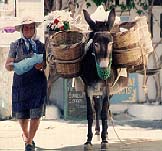 Nikitas did not arrive until 5 as he sent his helper who we did
not recognize. We paddled around until he finally arrived and then took him
out to the boat. While we paddled he got the motor running but it ran very
poorly. He said it was a spark plug and after replacing it the next day we
never had another problem with it. Nikitas examined the sail and said that
the head of the sail needed to be trimmed as it was too tall for the mast
and roller furling. We showed him our short list of critical problems and he
said to bring the boat around to the town quay where he could fix it. We
said we would be there by 9 a.m. We returned him to shore and got ready to
go to town.
Nikitas did not arrive until 5 as he sent his helper who we did
not recognize. We paddled around until he finally arrived and then took him
out to the boat. While we paddled he got the motor running but it ran very
poorly. He said it was a spark plug and after replacing it the next day we
never had another problem with it. Nikitas examined the sail and said that
the head of the sail needed to be trimmed as it was too tall for the mast
and roller furling. We showed him our short list of critical problems and he
said to bring the boat around to the town quay where he could fix it. We
said we would be there by 9 a.m. We returned him to shore and got ready to
go to town.
We got electrolyte for the battery and oil for the diesel engines.
We paddled our dinghy to shore and headed to town. Again, we went shopping a bit as the narrow streets void of traffic with sidewalk restaurants and quaint shops are excellent for bargain hunting and romantic dining. After ordering our dinner, while waiting for our main course, Val went shopping and returned with the rest of our crew. They had already eaten though they joined us for conversation and wine as we enjoyed a relaxing meal. People enjoyed the beautiful beaches and the time spent shopping in town. Again, half our crew spent half the day working on the boat and missed a good part of the island, especially the beautiful beaches and relaxation.
We went to shore early and prepared to journey to the nearby island of Delos. Since my trip there two years ago I had planned to return with my camera (left on the boat last time) to photograph the ancient civilization.
Kelly, George, and I planned to move the boat to the town quay, about an hour's drive under power. I called the manager at Vernicos to express our displeasure and get permission for Nikitas to trim our sail. I told him that we were totally miserable and he gave us Nikitas' phone number and said he would fix everything. Back aboard the boat we discovered the windlass would not work so we called Nikitas who came over about an hour later and repaired it. He left and we took the boat around to the main harbor and picked Nikitas up at the town dock who would help us moor stern-to the quay between a ferry and other boats (with only about 75 feet between the ferry and other boats). With amazing agility, he maneuvered the boat stern-to, between two other boats and never touching anything though we were running about the deck with fenders ready to fend off. We were amazed and impressed. Between noon and 7 pm we fixed the sail, windlass and remote control, and dinghy engine. He secured the batteries and soldered our primitive crimping job. The refrigerator now worked but the freezer did not. These were deemed the critical problems and Nikitas went on to fix four other boats that were waiting in line for his expert attention.
The rest of our crew did not show up after returning to Delos as they decided to go to the beach and have dinner on Mykonos. We knew that it would be noisy with bright lights making sleeping difficult on the town quay. There might also be a ferry sitting over our anchor when we decided to depart early the next morning so we left a note on the post by where our boat was moored and motored around the corner back to Ornos Bay. We were on anchor by 8:30 pm and ate aboard. The rest of the crew called on the VHF radio around 9:30 and we picked them up on the dock at midnight.
The crew was totally unhappy with the boat and we decided to give up any hope for help from the charter company and do the best we could to follow our agenda. Half the crew had been spending much time working on the boat and we felt that we traveled half way around the world to spend our vacation time doing boat repairs.
General comment - People are a little stressed. They are very dissatisfied with the boat. I have spent most of my time working on the boat and not enough time with Cathy and the others. I was unable to go to Delos which was my original mission and reason for coming to Greece. Kelly and George also missed it. My schedule is centered around maintenance. The boat was not seaworthy when it was given to me.
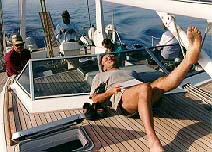 We awoke early and departed for Paros at 6:45 am. Fortunately,
Nikitas' repairs stayed fixed though we were still concerned about the
generator. We really wanted to go to Naoussa as it promised to be a most
beautiful anchorage but our concern for the reliability of the boat and
generator and dinghy made Paroikia a better choice. We were psyched to sail
but the wind was calm and the seas 1 to 2 feet. Our speed was 7.9 knots and
the distance to Paroikia was about 3 hours. The skies were clear. We arrived
on the dock by 10:00 am. No cars were available for rental so we decided to
make a reservation for Monday and take the ferry to Santorini, rent a car,
and return the following night though others had the option to stay an extra
day in Santorini and shorten their stay on Paros.
We awoke early and departed for Paros at 6:45 am. Fortunately,
Nikitas' repairs stayed fixed though we were still concerned about the
generator. We really wanted to go to Naoussa as it promised to be a most
beautiful anchorage but our concern for the reliability of the boat and
generator and dinghy made Paroikia a better choice. We were psyched to sail
but the wind was calm and the seas 1 to 2 feet. Our speed was 7.9 knots and
the distance to Paroikia was about 3 hours. The skies were clear. We arrived
on the dock by 10:00 am. No cars were available for rental so we decided to
make a reservation for Monday and take the ferry to Santorini, rent a car,
and return the following night though others had the option to stay an extra
day in Santorini and shorten their stay on Paros.
A boat next to us was leaving and they pulled up our anchor. It took a little while to reset the anchor.
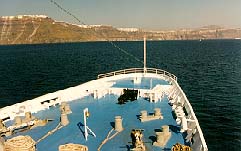 We decided to take the early afternoon ferry to Santorini. We
departed the ferry dock at 2 pm and arrived at 6 pm. We went to Kamari Tours
who helped us locate and book a hotel at Kamari Beach on the eastern side of
the island opposite from the caldera. It was very close to a black sand
beach with some towering cliffs and mountains nearby. It's very picturesque
here and the hotel prices are very reasonable. The Levande Hotel in Kamari
is about 100 meters from the beach. We were lucky to get the last two rooms.
They did not have any cars left so we got the last jeep. Monday is a holiday
and everything is getting booked. We spent 14,000 drs for the jeep and
13,000 for the hotel which includes breakfast. Our suite has a bedroom,
bathroom, sitting room, and verandah with a balcony view of the area. It's
very Greek and very beautiful. We ate dinner at Mapia's Restaurant right on
the water.
We decided to take the early afternoon ferry to Santorini. We
departed the ferry dock at 2 pm and arrived at 6 pm. We went to Kamari Tours
who helped us locate and book a hotel at Kamari Beach on the eastern side of
the island opposite from the caldera. It was very close to a black sand
beach with some towering cliffs and mountains nearby. It's very picturesque
here and the hotel prices are very reasonable. The Levande Hotel in Kamari
is about 100 meters from the beach. We were lucky to get the last two rooms.
They did not have any cars left so we got the last jeep. Monday is a holiday
and everything is getting booked. We spent 14,000 drs for the jeep and
13,000 for the hotel which includes breakfast. Our suite has a bedroom,
bathroom, sitting room, and verandah with a balcony view of the area. It's
very Greek and very beautiful. We ate dinner at Mapia's Restaurant right on
the water.
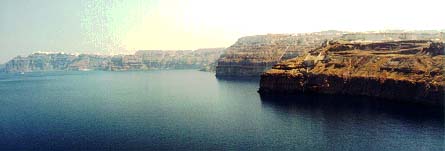 The first impression of volcanic Santorini, as
the ferry approaches, is one of majestic awe. The volcano first manifested
itself 80,000 years ago with a terrific eruption. Ash was found on the ocean
floor extending from Chios to Italy to North Africa and almost as far as
Cyprus. The island was about 10 miles wide. A civilization emerged about
2000 BC with two-story houses, agriculture including olive oil and wheat,
domesticated sheep for milk and cheese, decorated pottery, and a fishing
industry. They were able to produce wonderful paintings.
The first impression of volcanic Santorini, as
the ferry approaches, is one of majestic awe. The volcano first manifested
itself 80,000 years ago with a terrific eruption. Ash was found on the ocean
floor extending from Chios to Italy to North Africa and almost as far as
Cyprus. The island was about 10 miles wide. A civilization emerged about
2000 BC with two-story houses, agriculture including olive oil and wheat,
domesticated sheep for milk and cheese, decorated pottery, and a fishing
industry. They were able to produce wonderful paintings.
The volcano erupted for a second time in 1450 BC creating a giant caldera and destroying the ancient cities. Eighty four square kilometers of solid ground collapsed to the bed of the sea with an enormous black cloud of smoke and ash and a tidal wave 250 meters high speeding outwards at 350 kilometers per hour. It reached Crete in less than a half hour and drowned the whole Minoan civilization. The caldera is 10 km wide and 380 meters deep. Around 1300 BC Phoenicians colonized the island which continued as the alphabet was introduced (825 BC), Christianity was introduced (342 AD), Crusaders arrived (1204), and, more recently, the Adventure Club visited (1995, 1997).
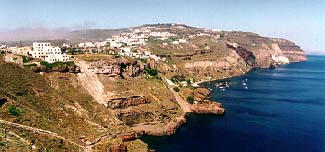 Today, Santorini is considered a favorite
island with a mixture of towering, sinister multi-colored volcanic cliffs
and brilliant-white trendy bars and restaurants. Several villages are built
into the cliffs near the top providing a most spectacular view of the
spectacular caldera with several smaller islands some of which are still
active volcano remnants. Along the western side of the island you will find
some of the most beautiful black sand beaches and beautiful beach villages
that are quaint and tastefully architect. The center of the island is quite
fertile and supports agriculture. There is no good place to anchor a sailing
vessel because water is deep and the bottom is steep near the shore. Ferry
docks accommodate many large ferries and a lot of tourist traffic supports
the island. Perhaps the most interesting ancient ruins can be found on
Santorini because the volcanic ash that was spewed from the earth in 1454 BC
completely covered the ancient towns thus preserving much of the pottery,
paintings, and architecture to some degree.
Today, Santorini is considered a favorite
island with a mixture of towering, sinister multi-colored volcanic cliffs
and brilliant-white trendy bars and restaurants. Several villages are built
into the cliffs near the top providing a most spectacular view of the
spectacular caldera with several smaller islands some of which are still
active volcano remnants. Along the western side of the island you will find
some of the most beautiful black sand beaches and beautiful beach villages
that are quaint and tastefully architect. The center of the island is quite
fertile and supports agriculture. There is no good place to anchor a sailing
vessel because water is deep and the bottom is steep near the shore. Ferry
docks accommodate many large ferries and a lot of tourist traffic supports
the island. Perhaps the most interesting ancient ruins can be found on
Santorini because the volcanic ash that was spewed from the earth in 1454 BC
completely covered the ancient towns thus preserving much of the pottery,
paintings, and architecture to some degree.
The eruption of the volcano was preceded by earthquakes, and the inhabitants had plenty of time to get organized and abandon their villages. No skeletons, either human or animal, were found. They likely took their valuable possessions. There may have been a period of calm which allowed some of the inhabitants to return and try to repair their half-ruined houses. Tools had been thrown down at various points. The space of time between earthquake and eruption may have been as much as a year because seeds had the time to sprout before being covered by lava.
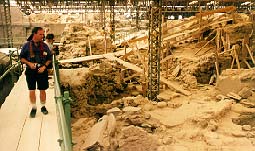
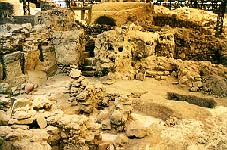 Our
visit to Akrotiri, an ancient village, was most impressive.
This Minoan town was discovered in 1967 by Marinatos. Excavations here are
difficult because as much as 10 meters of ash buried the village which is
like a cement tombstone. Many of the houses, up to three stories high, still
contain their huge storage pots. Narrow winding streets traverse the town,
circumventing large building complexes. Beneath the streets, drains carried
away the effluent from the houses. The drainage in each house was via
cylindrical clay pipes, incorporated in the walls of the building, which
linked up with the sewers under the streets. Akrotiri was an organized
community with high living standards, possibly governed by a priest caste.
Nature and Fertility were the objects of religious worship. Each house had
its own shrine, skillfully decorated with murals, and there was no temple as
such. The art of the inhabitants of Akrotiri was very similar to Cretan art
in the Minoan period. There is evidence to support the identification of the
early island with Atlantis. This archaeological site is unique - it is a
place of routine, daily life. It is easy to imagine people living here.
Excavation has uncovered a long and narrow section of the city, running
along a north-south axis.
Our
visit to Akrotiri, an ancient village, was most impressive.
This Minoan town was discovered in 1967 by Marinatos. Excavations here are
difficult because as much as 10 meters of ash buried the village which is
like a cement tombstone. Many of the houses, up to three stories high, still
contain their huge storage pots. Narrow winding streets traverse the town,
circumventing large building complexes. Beneath the streets, drains carried
away the effluent from the houses. The drainage in each house was via
cylindrical clay pipes, incorporated in the walls of the building, which
linked up with the sewers under the streets. Akrotiri was an organized
community with high living standards, possibly governed by a priest caste.
Nature and Fertility were the objects of religious worship. Each house had
its own shrine, skillfully decorated with murals, and there was no temple as
such. The art of the inhabitants of Akrotiri was very similar to Cretan art
in the Minoan period. There is evidence to support the identification of the
early island with Atlantis. This archaeological site is unique - it is a
place of routine, daily life. It is easy to imagine people living here.
Excavation has uncovered a long and narrow section of the city, running
along a north-south axis. 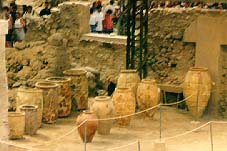
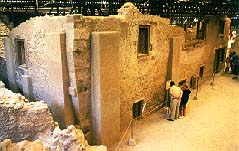 Pithoi Storeroom was a place where
produce was stored in large jars such as those lined up here. More than
fifty different shapes have been distinguished among the thousands of vases
that have been excavated to date. Some were made locally and some brought
from elsewhere. The foreign vases are of better quality believing to have
originated in Crete and some from mainland Greece. The Cretan vases exhibit
a wider variety of decoration. The local vases can be counted in the
thousands and larger than the foreign ones. There are thousands of conical
cups, hundreds of tripod cooking pots, amphorae, pithoi, stirrup jars, bath
tubs, various ewers, strainers, plant pots, flower vases, and so on. of
fishermen and West House is near the "Triangular
Square" complex and two wall-paintings famous miniature frescoes were
found.
Pithoi Storeroom was a place where
produce was stored in large jars such as those lined up here. More than
fifty different shapes have been distinguished among the thousands of vases
that have been excavated to date. Some were made locally and some brought
from elsewhere. The foreign vases are of better quality believing to have
originated in Crete and some from mainland Greece. The Cretan vases exhibit
a wider variety of decoration. The local vases can be counted in the
thousands and larger than the foreign ones. There are thousands of conical
cups, hundreds of tripod cooking pots, amphorae, pithoi, stirrup jars, bath
tubs, various ewers, strainers, plant pots, flower vases, and so on. of
fishermen and West House is near the "Triangular
Square" complex and two wall-paintings famous miniature frescoes were
found.
Our journey next took us to the Monastery Profitis Ilias on top of Mesa Vouna. There were great views but the monastery was closed. Later we discovered that it was closed for the past several years though the guide books and locals were not really aware of this. This monastery was built in 1712 on Santorini's highest point (566m). On a clear day, Crete is visible.
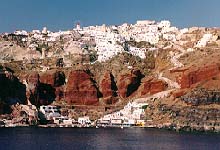
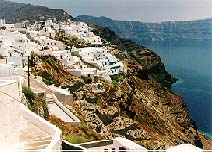 Our
next stop was Oia, pronounced "Ia," at the
northern end of the island which took about 40 minutes to reach by car. Oia
is the third port of Santorini and is the most picturesque village on
Santorini. Until World War II, Oia was the commercial center of the island.
Today, it is very less touristy and a most excellent place to rent a room
with a most excellent view. The town is nestled on the lip
of the crater with no apparent commercial development except for a few
souvenir shops. We found Oia to be a peaceful place of great beauty. It
would be most excellent to spend a week in a pension here reading or writing
in the tranquility of a most ancient village. Our drive from Akrotiri to Oia
took us the length of the island where we had excellent views of the
agricultural sections which were very fertile from the volcanic pumice. East
of the farms along the cost we could see beaches in the distance though we
did not have time to visit.
Our
next stop was Oia, pronounced "Ia," at the
northern end of the island which took about 40 minutes to reach by car. Oia
is the third port of Santorini and is the most picturesque village on
Santorini. Until World War II, Oia was the commercial center of the island.
Today, it is very less touristy and a most excellent place to rent a room
with a most excellent view. The town is nestled on the lip
of the crater with no apparent commercial development except for a few
souvenir shops. We found Oia to be a peaceful place of great beauty. It
would be most excellent to spend a week in a pension here reading or writing
in the tranquility of a most ancient village. Our drive from Akrotiri to Oia
took us the length of the island where we had excellent views of the
agricultural sections which were very fertile from the volcanic pumice. East
of the farms along the cost we could see beaches in the distance though we
did not have time to visit.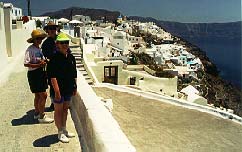
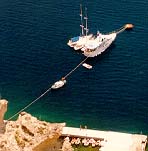 We enjoyed walking the narrow
walkways along the top of town on the caldera rim and enjoyed lunch
and a little shopping. We noticed a couple sailboats moored below realizing
the difficulty that they must have had securing their boat in the deep
water. The moorings are laid in very deep water a couple
hundred feet off shore. The vessel must be secured bow towards the mooring
and a stern line secured on dock. The dinghy is used as a ferry and most
often pulled along the stern line. In bad weather the caldera can get quite
rough as we noticed on a previous trip when four boats were moored together
and one of the lines broke allowing the vessel to severely damage the
neighboring boat. It is most safe to leave one's yacht in Paros or Ios (even
closer) and take one of the ferries to Santorini because of the limited
space and difficulty mooring especially in rough weather. Here, we observed
that it is better to be called a wimp by your friends than a fool by the
press.
We enjoyed walking the narrow
walkways along the top of town on the caldera rim and enjoyed lunch
and a little shopping. We noticed a couple sailboats moored below realizing
the difficulty that they must have had securing their boat in the deep
water. The moorings are laid in very deep water a couple
hundred feet off shore. The vessel must be secured bow towards the mooring
and a stern line secured on dock. The dinghy is used as a ferry and most
often pulled along the stern line. In bad weather the caldera can get quite
rough as we noticed on a previous trip when four boats were moored together
and one of the lines broke allowing the vessel to severely damage the
neighboring boat. It is most safe to leave one's yacht in Paros or Ios (even
closer) and take one of the ferries to Santorini because of the limited
space and difficulty mooring especially in rough weather. Here, we observed
that it is better to be called a wimp by your friends than a fool by the
press. 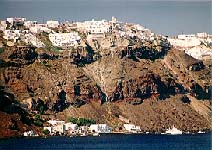
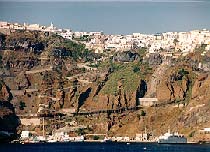 The
capital, Thira, proudly dominates the rim of the caldera
with a command view of the island, caldera, and smoking volcano in front.
Kato Phira is framed by two masterpieces of ecclesiastical architecture -
Agio Minas and Christos. The carved wooden altar screen and Episcopal throne
in Christos are fine examples of the art of anonymous artisans. The
Archaeological Museum is worth a visit which displays vases and figurines of
the early Cycladic periods (2500-2000 BC) and pottery from the Akrotiri
excavations (1500 BC). The famous Santorini frescoes are still in the
National Museum in Athens. A short walk from the Museum is the Convent of
the Dominican sisters which is a school of carpet-making of the Hellenic
Handicraft Organization. The Megaron Gyzi museum, located in a beautiful
17th-century mansion, houses exhibits on the island's history - manuscripts
from the 16th-19th centuries, costumes, old maps, and some photographs of
Santorini before the 1956 earthquake. A fun excursion is to ride the donkeys
down a winding path to Athinios at the base of the cliffs
by the water. A cable car provides a more modern means of commuting though
the energetic can easily walk the path. On the cliff is hung cafés and
restaurants, all boasting one of the world's most magnificent views.
The
capital, Thira, proudly dominates the rim of the caldera
with a command view of the island, caldera, and smoking volcano in front.
Kato Phira is framed by two masterpieces of ecclesiastical architecture -
Agio Minas and Christos. The carved wooden altar screen and Episcopal throne
in Christos are fine examples of the art of anonymous artisans. The
Archaeological Museum is worth a visit which displays vases and figurines of
the early Cycladic periods (2500-2000 BC) and pottery from the Akrotiri
excavations (1500 BC). The famous Santorini frescoes are still in the
National Museum in Athens. A short walk from the Museum is the Convent of
the Dominican sisters which is a school of carpet-making of the Hellenic
Handicraft Organization. The Megaron Gyzi museum, located in a beautiful
17th-century mansion, houses exhibits on the island's history - manuscripts
from the 16th-19th centuries, costumes, old maps, and some photographs of
Santorini before the 1956 earthquake. A fun excursion is to ride the donkeys
down a winding path to Athinios at the base of the cliffs
by the water. A cable car provides a more modern means of commuting though
the energetic can easily walk the path. On the cliff is hung cafés and
restaurants, all boasting one of the world's most magnificent views.
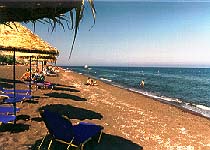 The black sand at Perissa Beach is perhaps the
most beautiful on the island. The stony mass of Mesa Vouno rises almost
perpendicularly at the eastern end of the beach. The majestic Perissa
church, dedicated to the Holy Cross, is a pilgrimage for the islanders and
rises out of the sand at a spot where one would expect at most a little
chapel. There are tamarisks (umbrellas) for shade, a restaurant, showers,
and very few people. We enjoyed the shade, sun, and sea at this beautiful
beach at the end of our day after visiting the Boutari winery where we
enjoyed sampling some of their wines (bought a few bottles for home). The
summer days can get quite hot and the beach or cool shade in the early to
mid afternoon is most welcome.
The black sand at Perissa Beach is perhaps the
most beautiful on the island. The stony mass of Mesa Vouno rises almost
perpendicularly at the eastern end of the beach. The majestic Perissa
church, dedicated to the Holy Cross, is a pilgrimage for the islanders and
rises out of the sand at a spot where one would expect at most a little
chapel. There are tamarisks (umbrellas) for shade, a restaurant, showers,
and very few people. We enjoyed the shade, sun, and sea at this beautiful
beach at the end of our day after visiting the Boutari winery where we
enjoyed sampling some of their wines (bought a few bottles for home). The
summer days can get quite hot and the beach or cool shade in the early to
mid afternoon is most welcome.
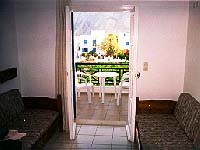 We enjoyed our stay at the Armonia Hotel at
Kamari Beach. The price was about $50 per room where we enjoyed our bedroom,
private bath, small living room, and lovely balcony with an excellent view.
The front of the hotel was on the waterfront by a beautiful black sand
beach. The waterfront was lined with restaurants that were modestly priced
(inexpensive by our standards) and the food was excellent, as always. The
people were very friendly.
We enjoyed our stay at the Armonia Hotel at
Kamari Beach. The price was about $50 per room where we enjoyed our bedroom,
private bath, small living room, and lovely balcony with an excellent view.
The front of the hotel was on the waterfront by a beautiful black sand
beach. The waterfront was lined with restaurants that were modestly priced
(inexpensive by our standards) and the food was excellent, as always. The
people were very friendly.
We decided to catch the 8 pm ferry back to Paros arriving at midnight. Hossein and George tightened the anchor chain and the boat was looking good. We ran the generator for 30 minutes before retiring for the night. We highly recommend Santorini because of it's unique ancient ruins, unique towns perched on the volcano rim, and friendly people.
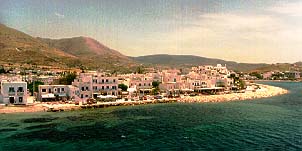
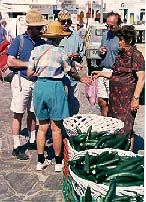 We spent
the day exploring the island of Paros. In the main town, Paroika,
we vound many small shops and a market on the waterfront by
the harbor. We shopped for fresh vegetables and discovered some most
excellent cucumber-like vegetables that we often munched on. Paros receives
thousands of tourists each summer though the island has remained less
touristy than neighboring Mykonos. The Cycladic style of houses, narrow
alleys, little bridges and balconies overflowing with potted plants gives
the towns a romantic charm. Except for the port and beaches, there is little
evidence of tourism by our standards and the island retains a Greek island
atmosphere. Kelly, Val, Tony and I rented a car with plans to tour the
island. The island was famous for some of the finest, most translucent
marble in the world, prized by Classical sculptors and architects. Today,
the island is very fertile and supports vineyards, wheat and barley, citrus
and olives, and pastures for sheep and cattle. Their beaches are also most
excellent and there is a famous valley filled with butterflies in the
summer. There are several monasteries worth visiting.
We spent
the day exploring the island of Paros. In the main town, Paroika,
we vound many small shops and a market on the waterfront by
the harbor. We shopped for fresh vegetables and discovered some most
excellent cucumber-like vegetables that we often munched on. Paros receives
thousands of tourists each summer though the island has remained less
touristy than neighboring Mykonos. The Cycladic style of houses, narrow
alleys, little bridges and balconies overflowing with potted plants gives
the towns a romantic charm. Except for the port and beaches, there is little
evidence of tourism by our standards and the island retains a Greek island
atmosphere. Kelly, Val, Tony and I rented a car with plans to tour the
island. The island was famous for some of the finest, most translucent
marble in the world, prized by Classical sculptors and architects. Today,
the island is very fertile and supports vineyards, wheat and barley, citrus
and olives, and pastures for sheep and cattle. Their beaches are also most
excellent and there is a famous valley filled with butterflies in the
summer. There are several monasteries worth visiting.
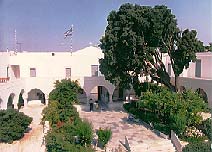
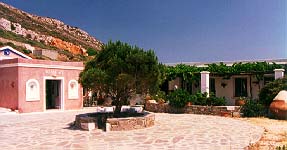 It was a holiday so we visited the town church
in Paroikia at 9:20 where a service was in progress (in Greek) so we took a
few photos of the outside and visited the little museum and shop. The museum
was well worth a visit as it captured the history of religion for the
island. The church is called "The Church of a Hundred Doors"
though it really has 99 doors. We nexted headed towards Lefkas where,
enroute, we discovered a craft shop with some excellent
pottery. The potter and his wife had built their estate on the side of a
mountain with a view of Lefkas and the surrounding hills. It was a very
peaceful place and very artistic. On the estate they had built a small shop
that displayed their most excellent products, a large working space, and
comfortable living quarters.
It was a holiday so we visited the town church
in Paroikia at 9:20 where a service was in progress (in Greek) so we took a
few photos of the outside and visited the little museum and shop. The museum
was well worth a visit as it captured the history of religion for the
island. The church is called "The Church of a Hundred Doors"
though it really has 99 doors. We nexted headed towards Lefkas where,
enroute, we discovered a craft shop with some excellent
pottery. The potter and his wife had built their estate on the side of a
mountain with a view of Lefkas and the surrounding hills. It was a very
peaceful place and very artistic. On the estate they had built a small shop
that displayed their most excellent products, a large working space, and
comfortable living quarters. 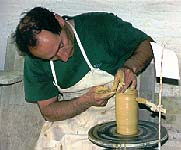
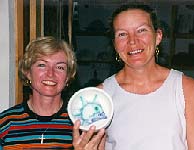 The potter is a talented artist
and sells his wares throughout the island to merchants such as hotels and
restaurants. He is well known among the locals on the island and was
recommended by several people on the island as being the best so we were
very fortunate to have discovered his place during our travels. They were
both very friendly and shared a small part of their lives with us. After our
visit, we purchased some pottery (got my favorite bowl
here). This was perhaps one of the two best potters we had found in our
entire sailing adventure ans well worth the visit. They are planning on
taking a sabatical in the US for a year or two and are looking for someone
to take care of their place, perhaps trade places for a while. So, if you
are into pottery and want to spend a year or two in a little piece of
paradise then send them a note.
The potter is a talented artist
and sells his wares throughout the island to merchants such as hotels and
restaurants. He is well known among the locals on the island and was
recommended by several people on the island as being the best so we were
very fortunate to have discovered his place during our travels. They were
both very friendly and shared a small part of their lives with us. After our
visit, we purchased some pottery (got my favorite bowl
here). This was perhaps one of the two best potters we had found in our
entire sailing adventure ans well worth the visit. They are planning on
taking a sabatical in the US for a year or two and are looking for someone
to take care of their place, perhaps trade places for a while. So, if you
are into pottery and want to spend a year or two in a little piece of
paradise then send them a note.
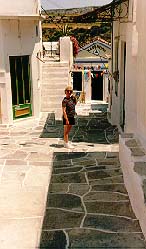
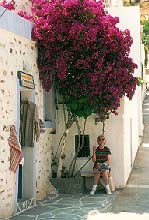 Our next
stop was Lefkas - the ancient capital of the island - with their narrow
sidewalks and quaint shops and romantic charm. We ate lunch on the
edge of town with an excellent view of the village and surrounding hills.
The afternoon sun was hot and the temperatures were now well into the
90º's. After lunch we explored the village and stopped at a weaver's
shop. There was a cool tree just outside. The shop was very small
and packed with hand made shirts, rugs, and other clothing items. The woman
did not speak much English but was happy to converse with us in spite of our
poor articulation and lots of theatrics. We continued our walk towards the
village church which we saw from our restaurant before we set out on our
pilgrimage. Now, we would catch a glimpse of the church when the narrow
sidewalks were aligned in the right direction and we followed the maze until
we found it. The village church was majestic but closed. So, we continued
through the maze in the general direction of our car. Like surprised mice,
we emerged from the labrinth just a short distance from our car where we
continued our journey. Our next goal would be Naoussa, the island's second
port, with a very picturesque bay. Along the route to Naoussa there are many
historical attractions such as a 7th century basilica (built in 4th century
BC) and the temple of Delian Apollo. We first entered Naoussa by a fishing
village with colorful boats. The small harbor was comletely
protected with restaurants and shops on three sides and a breakwater on the
fourth.
Our next
stop was Lefkas - the ancient capital of the island - with their narrow
sidewalks and quaint shops and romantic charm. We ate lunch on the
edge of town with an excellent view of the village and surrounding hills.
The afternoon sun was hot and the temperatures were now well into the
90º's. After lunch we explored the village and stopped at a weaver's
shop. There was a cool tree just outside. The shop was very small
and packed with hand made shirts, rugs, and other clothing items. The woman
did not speak much English but was happy to converse with us in spite of our
poor articulation and lots of theatrics. We continued our walk towards the
village church which we saw from our restaurant before we set out on our
pilgrimage. Now, we would catch a glimpse of the church when the narrow
sidewalks were aligned in the right direction and we followed the maze until
we found it. The village church was majestic but closed. So, we continued
through the maze in the general direction of our car. Like surprised mice,
we emerged from the labrinth just a short distance from our car where we
continued our journey. Our next goal would be Naoussa, the island's second
port, with a very picturesque bay. Along the route to Naoussa there are many
historical attractions such as a 7th century basilica (built in 4th century
BC) and the temple of Delian Apollo. We first entered Naoussa by a fishing
village with colorful boats. The small harbor was comletely
protected with restaurants and shops on three sides and a breakwater on the
fourth. 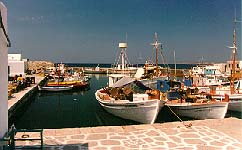
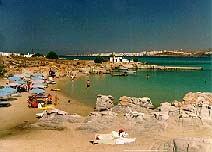 Nearby, restaurants dry fish and seafood
for their evening fare. Lunch of fresh seafood is most excellent here as
shade from the hot afternoon sun is a good idea. The beaches
of Naoussa are most extraordinary though they are crowded compared to the
beaches on the eastern side of the island. After our visit to Naoussa, we
went to the beach at Santa Maria where we bumped into Doug on his moped. We
spent the rest of the afternoon enjoying the beach, water, shade, and noted
the topless features of European beaches. About 6 pm we headed back to the
boat where we got ready for dinner, shopped in town, and ate at Levante's
restaurant. It was excellent and did not have the usual pint of olive oil in
each dish. We returned to the boat about midnight as the shops stay open
very late. Here, we felt the shopping was the best in all the islands and
the town of Paros was perhaps our favorite island so far. This was perhaps
the second enjoyable day as no maintenance was done on the boat.
Nearby, restaurants dry fish and seafood
for their evening fare. Lunch of fresh seafood is most excellent here as
shade from the hot afternoon sun is a good idea. The beaches
of Naoussa are most extraordinary though they are crowded compared to the
beaches on the eastern side of the island. After our visit to Naoussa, we
went to the beach at Santa Maria where we bumped into Doug on his moped. We
spent the rest of the afternoon enjoying the beach, water, shade, and noted
the topless features of European beaches. About 6 pm we headed back to the
boat where we got ready for dinner, shopped in town, and ate at Levante's
restaurant. It was excellent and did not have the usual pint of olive oil in
each dish. We returned to the boat about midnight as the shops stay open
very late. Here, we felt the shopping was the best in all the islands and
the town of Paros was perhaps our favorite island so far. This was perhaps
the second enjoyable day as no maintenance was done on the boat.
Janet and Carolanne decided to stay an extra night in Santorini. George and Hossein returned shortly after us as George has friends on the island.
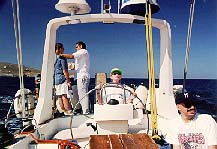 Cathy
and I went for an early morning walk in Paros. After breakfast we went to
several money machines where Cathy found success while my cards did not
work. A bank was happy to provide money for my Visa (lower fees than
MasterCard in Greece). Back aboard by 9:30, Doug was feeling ill and decided
to take the next ferry home. We were underway by 12:30 pm.
Cathy
and I went for an early morning walk in Paros. After breakfast we went to
several money machines where Cathy found success while my cards did not
work. A bank was happy to provide money for my Visa (lower fees than
MasterCard in Greece). Back aboard by 9:30, Doug was feeling ill and decided
to take the next ferry home. We were underway by 12:30 pm.
The sail was most excellent as the wind was from the north at 15 knots and we were able to make 7 knots under sail. The temperatures were in the mid 90°'s F and the seas were slight. We cooked pasta underway for a late lunch. Enroute we saw dolphins. This was the best day sailing (okay, the first day sailing). We anchored in Vathi by 6:30 pm and were swimming in the warm, clear water. The anchorage is very beautiful and well protected. Mountains rise in all directions with a small inlet offering protection from most seas. After our leisurely swim, we prepared for dinner aboard where Janet and Carolanne made a most excellent pasta dinner. We were pleased with the excellent sailing characteristics of the boat and felt lucky with our choice of anchorages.
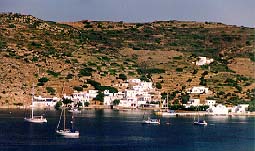
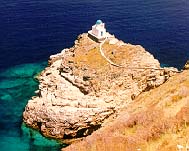 We went to shore at 8 am expecting a very hot day.
We started hiking to the Chrissopigi Monastery and found the early morning
heat a bit more than expected. Already it had reached near 90 degrees as we
hiked up a mountain road. Few cars passed but we were able to get a ride in
a car and van to Apollonia where we tanked up on water and drinks. Here we
split up and some when to visit the monastery, some headed for the beach,
and others walked to the town of Artemonas for lunch and treasure seeking.
Kelly, Val, Cathy, and I went after lunch to visit the small town of Kastro
by taxi (very inexpensive for four people). Then, we went to Kamares, the
main port on the island. Everything was closed between 2 and 5 pm as it get
oppressively hot, so we decided to head back to the boat for a refreshing
swim. At the beach by our boat, we had ice cream, dinghied to the potter who
was the best we had seen, and then enjoyed a refreshing dip in the water by
the boat. As it became cool, we enjoyed our drinks and dancing on deck and
planned to eat aboard though with refrigerator difficulties we decided to go
to shore. We had a most excellent dinner on the waterfront with lots of
singing and carrying on. Happiness was shared by all.
We went to shore at 8 am expecting a very hot day.
We started hiking to the Chrissopigi Monastery and found the early morning
heat a bit more than expected. Already it had reached near 90 degrees as we
hiked up a mountain road. Few cars passed but we were able to get a ride in
a car and van to Apollonia where we tanked up on water and drinks. Here we
split up and some when to visit the monastery, some headed for the beach,
and others walked to the town of Artemonas for lunch and treasure seeking.
Kelly, Val, Cathy, and I went after lunch to visit the small town of Kastro
by taxi (very inexpensive for four people). Then, we went to Kamares, the
main port on the island. Everything was closed between 2 and 5 pm as it get
oppressively hot, so we decided to head back to the boat for a refreshing
swim. At the beach by our boat, we had ice cream, dinghied to the potter who
was the best we had seen, and then enjoyed a refreshing dip in the water by
the boat. As it became cool, we enjoyed our drinks and dancing on deck and
planned to eat aboard though with refrigerator difficulties we decided to go
to shore. We had a most excellent dinner on the waterfront with lots of
singing and carrying on. Happiness was shared by all.
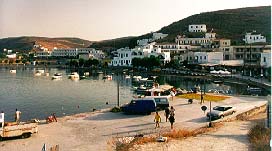
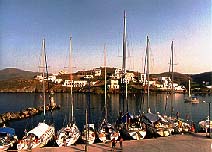 Clear skies, calm winds and seas as we motored to
Loutra, departing Vathi at 7:30 am. The morning temperature was 82°F and
our boat speed under power was 7 knots. We were estimating Loutra at 2 pm.
At 9:50 am the engine sounded peculiar though there was not change in oil
pressure or cooling water flow so with a little worry we continued. At 10:30
am the wind picked up and we sailed at 5-6 knots in 12-15 knots of wind
though it died less than two hours later. We entered Loutra harbor at 1 pm
and checked out the different mooring locations. We decided to moor stern to
the quay and were settled in by 2 pm. The temperature in the shade was in
the upper 90°'s F and 110°F on the pavement as we walked through town
(very small waterfront town). Nearby, we ate lunch and spent the afternoon
relaxing on the boat followed by swimming at a nearby beach. Very pleasant!
As we got ready for dinner we watched the late afternoon rush of other boats
enter only to find no room on the quay and then compete for the choice
anchor spots as some areas were either very deep, too narrow, or both.
Loutra is very quiet and there are not many tourists. Loutra is noted for
their mineral hot springs near town. After dinner, we retired early. We ate
dinner at Zorbas who offered free showers and boat water to their customers.
Clear skies, calm winds and seas as we motored to
Loutra, departing Vathi at 7:30 am. The morning temperature was 82°F and
our boat speed under power was 7 knots. We were estimating Loutra at 2 pm.
At 9:50 am the engine sounded peculiar though there was not change in oil
pressure or cooling water flow so with a little worry we continued. At 10:30
am the wind picked up and we sailed at 5-6 knots in 12-15 knots of wind
though it died less than two hours later. We entered Loutra harbor at 1 pm
and checked out the different mooring locations. We decided to moor stern to
the quay and were settled in by 2 pm. The temperature in the shade was in
the upper 90°'s F and 110°F on the pavement as we walked through town
(very small waterfront town). Nearby, we ate lunch and spent the afternoon
relaxing on the boat followed by swimming at a nearby beach. Very pleasant!
As we got ready for dinner we watched the late afternoon rush of other boats
enter only to find no room on the quay and then compete for the choice
anchor spots as some areas were either very deep, too narrow, or both.
Loutra is very quiet and there are not many tourists. Loutra is noted for
their mineral hot springs near town. After dinner, we retired early. We ate
dinner at Zorbas who offered free showers and boat water to their customers.
We were planning an early morning departure and would awake at 3 am to experience a little night sail. The moon was full and the evening was well lit in the clear skies. We expected to be back to Athens by noon though it would be very hot.
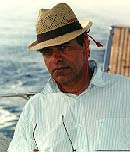 Awoke at 2:45 am and rallied the crew at 3 am for an early
morning departure. We were amazed that we were clear of all the anchors at
the town quay. The temperature below deck was 81°F. Both wind and sea were
calm. Our speed under power was 7 knots. The fog restricted visibility to
about 2 miles and radar navigation was helpful. Several large ferries
passed. The sunrise was beautiful though it quickly became hazy and hot. Our
estimate for Kalamaki marine in Athens was 11 am. Prior to departure we made
a watch schedule and skipper was on deck throughout. We arrived as planned
at the dock and did an excellent job docking in spite of twisted mooring
lines floating in the water. Simon greeted us.
Awoke at 2:45 am and rallied the crew at 3 am for an early
morning departure. We were amazed that we were clear of all the anchors at
the town quay. The temperature below deck was 81°F. Both wind and sea were
calm. Our speed under power was 7 knots. The fog restricted visibility to
about 2 miles and radar navigation was helpful. Several large ferries
passed. The sunrise was beautiful though it quickly became hazy and hot. Our
estimate for Kalamaki marine in Athens was 11 am. Prior to departure we made
a watch schedule and skipper was on deck throughout. We arrived as planned
at the dock and did an excellent job docking in spite of twisted mooring
lines floating in the water. Simon greeted us.
Shortly after our arrival, black smoke billowed from the aft generator compartment. We shut down the generator and grabbed fire extinguishers as we headed towards the stern of the boat. No fire, just smoke, and a dead generator appearing to be a blown head gasket. Our decision to leave the boat early and head to a hotel in the Plaka in Athens was good. It was centrally located with the major sites accessible by foot.
Vernicos Yachts offered us a refund for 4 days which we thought was appropriate for the days we left or missed because of maintenance but it did not account for the quality of the vessel for the first five days of sailing. We were, however, glad to have some money returned as some of us felt that we flew half way around the world to spend a week working on the boat.
We spent the evening exploring the town and enjoyed another authentic Greek meal.
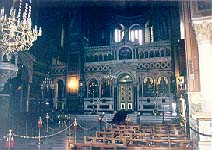
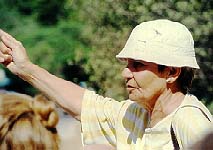 After a breakfast of bread, jelly, and juice, we
began the day with a half-day bus tour. It showed us the local highlights
and our tour guide was most informative. We rode through the town, visited a
6th century BC church in town, and finally ended at the
Acropolis where we got a great guided tour. Our tour guide
was most excellent and was a highlight of the morning tour. During our
morning tour we were able to get a good idea of where we wanted to spend our
time for the remainder of the day. Our plan was to spend some time at the
Acropolys and then the old part of town, called the Plaka. At the end of the
morning tour we were left to explore the Acropolys, visit the museum, and
then we walked down the hill through the Plaka to our hotel.
After a breakfast of bread, jelly, and juice, we
began the day with a half-day bus tour. It showed us the local highlights
and our tour guide was most informative. We rode through the town, visited a
6th century BC church in town, and finally ended at the
Acropolis where we got a great guided tour. Our tour guide
was most excellent and was a highlight of the morning tour. During our
morning tour we were able to get a good idea of where we wanted to spend our
time for the remainder of the day. Our plan was to spend some time at the
Acropolys and then the old part of town, called the Plaka. At the end of the
morning tour we were left to explore the Acropolys, visit the museum, and
then we walked down the hill through the Plaka to our hotel.
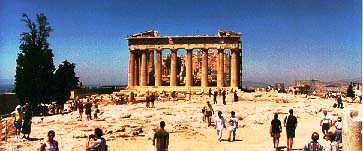
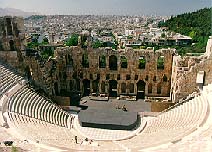 The Acropolis is on a hill in the center of town
making it a natural fortification. The path to the Acropolis follows a path
laid out at the consecration of the Panthenaic Festival in 566 BC. The
entrance is defended by the Beulé Gate, a monumental stairway built by the
Romans, and two lions from Venice. A massive gateway, Propylaia, was
considered by ancient Greeks equal to the Parthenon itself, although it was
never completed because of the Peloponnesian War. The Ionic Temple of Athena
Nike, or Wingless Victory, was built in 478 BC of Pentelic marble
with the statue of Athena inside. In 1687 the Turks destroyed the temple to
build a tower. The Parthenon, originally called the Great
Temple,is one of the most famous buildings in the world. The Doric templte
was constructed between 447 and 432 BC. It was constructed entirely of
Pentelic marble and originally contained a statue of Athena Parthenos, more
than 36 feet high made of ivory and gold. The Parthenon's foundation is
curved slightly to prevent an illusion of drooping caused by straight
horizontals. The columns are bent a few centimeters inward to make them
appear straight. Corner columns are wider to complete the appearance of
perfect form. In 1687 a Venetian bomb hit the Turs' powder kegs stored
inside the Parthenon; in 1894 an earthquake further destroyed the building;
and today smog takes its toll. The last great monument on the Acropolis is
the Erechtheion, a peculiar Ionic temple. On the south side of the Acropolis
is the Theater of Dionysos used from the 6th century BC.
The Theater of Herodes Atticus was built in AD 161 and now
hosts the annual mid-May and September Festival of Athens. The Acropolis
Museum houses sculptures and reliefs from the temples. There are many
museums in town worth visiting.
The Acropolis is on a hill in the center of town
making it a natural fortification. The path to the Acropolis follows a path
laid out at the consecration of the Panthenaic Festival in 566 BC. The
entrance is defended by the Beulé Gate, a monumental stairway built by the
Romans, and two lions from Venice. A massive gateway, Propylaia, was
considered by ancient Greeks equal to the Parthenon itself, although it was
never completed because of the Peloponnesian War. The Ionic Temple of Athena
Nike, or Wingless Victory, was built in 478 BC of Pentelic marble
with the statue of Athena inside. In 1687 the Turks destroyed the temple to
build a tower. The Parthenon, originally called the Great
Temple,is one of the most famous buildings in the world. The Doric templte
was constructed between 447 and 432 BC. It was constructed entirely of
Pentelic marble and originally contained a statue of Athena Parthenos, more
than 36 feet high made of ivory and gold. The Parthenon's foundation is
curved slightly to prevent an illusion of drooping caused by straight
horizontals. The columns are bent a few centimeters inward to make them
appear straight. Corner columns are wider to complete the appearance of
perfect form. In 1687 a Venetian bomb hit the Turs' powder kegs stored
inside the Parthenon; in 1894 an earthquake further destroyed the building;
and today smog takes its toll. The last great monument on the Acropolis is
the Erechtheion, a peculiar Ionic temple. On the south side of the Acropolis
is the Theater of Dionysos used from the 6th century BC.
The Theater of Herodes Atticus was built in AD 161 and now
hosts the annual mid-May and September Festival of Athens. The Acropolis
Museum houses sculptures and reliefs from the temples. There are many
museums in town worth visiting.
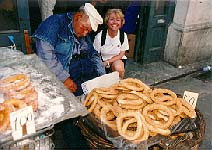
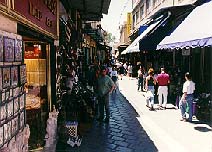 As we walked down the hill we discovered Ancient
Agora which was the heart of civic and social life. Here, Socrates
questioned their basic conceptions of life and law and eventually was
believed to have been placed in prison and likely poisoned with Hemlock. We
walked back to the old town through the flea market where
local vendors sell everything from fresh foods to antiques to leather
products. We found a most excellent grill that sold the best gyros for 80¢
US. We continued our shopping in the Plaka excellent for
souvenirs and restaurants and tavernas. Our visit to the Plaka was
productive as we discovered excellent T-shirts, oil paintings ($9 US),
souvenirs, and rugs. Back to the hotel for some rest before dinner. We
splurged for dinner which was perhaps the best and most expensive that we
enjoyed ($12 US). Later that night we finished packing. It was very hot,
perhaps considered oppressively hot which the papers said was unusual. On
Thursday, two days earlier, 100 people were hospitalized in Athens because
of the heat. It was in the 90°'s and very humid and most places are not air
conditioned.
As we walked down the hill we discovered Ancient
Agora which was the heart of civic and social life. Here, Socrates
questioned their basic conceptions of life and law and eventually was
believed to have been placed in prison and likely poisoned with Hemlock. We
walked back to the old town through the flea market where
local vendors sell everything from fresh foods to antiques to leather
products. We found a most excellent grill that sold the best gyros for 80¢
US. We continued our shopping in the Plaka excellent for
souvenirs and restaurants and tavernas. Our visit to the Plaka was
productive as we discovered excellent T-shirts, oil paintings ($9 US),
souvenirs, and rugs. Back to the hotel for some rest before dinner. We
splurged for dinner which was perhaps the best and most expensive that we
enjoyed ($12 US). Later that night we finished packing. It was very hot,
perhaps considered oppressively hot which the papers said was unusual. On
Thursday, two days earlier, 100 people were hospitalized in Athens because
of the heat. It was in the 90°'s and very humid and most places are not air
conditioned.
Our taxi picked us up at 6:15 am for a 7:50 am departure. It was funny that I asked the driver how much to the airport and, though he tried to avoid the question, he said 2000 drs. I made it clear that I would pay the hotel with my remaining drs and would not have any more money. At the airport the price went up to 2500 drs which was typical. Our flight home was uneventful.
In summary, the Mediterranean is a most excellent area to sail though the distances between islands are greater than the Caribbean and some of the other places we have visited. The large sail boat was fast and comfortable for the most part.
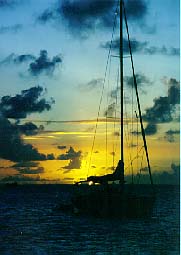
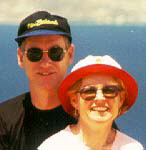 John
Beck is an avid sailor and instructor with the American Sailing
Association (in addition to a "day" job). During the year he
leads several sailing flotillas and instructional workshops throughout
the world. He has a unique ability to blend in with the natives so he
is inconspicuous and indistinguishable from the local color. Over the
past decade he has lead so many sailing trips in the Caribbean that he
considers the warm tropical waters his second home. Cathy Lavelle
first boarded a boat and also first experienced the South Pacific
islands on this trip. She was amazed at the beauty of the islands, the
comfort aboard the boat, and the company of the other crew members.
She immediately made friends with everyone and helped make life aboard
a special experience. Cathy is a most excellent cook and a great asset
on any sailing trip. John
Beck is an avid sailor and instructor with the American Sailing
Association (in addition to a "day" job). During the year he
leads several sailing flotillas and instructional workshops throughout
the world. He has a unique ability to blend in with the natives so he
is inconspicuous and indistinguishable from the local color. Over the
past decade he has lead so many sailing trips in the Caribbean that he
considers the warm tropical waters his second home. Cathy Lavelle
first boarded a boat and also first experienced the South Pacific
islands on this trip. She was amazed at the beauty of the islands, the
comfort aboard the boat, and the company of the other crew members.
She immediately made friends with everyone and helped make life aboard
a special experience. Cathy is a most excellent cook and a great asset
on any sailing trip. |
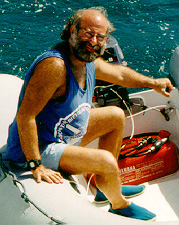 Doug Rapkine is an excellent sailor,
boat owner, and skipper whose enthusiasm and helpfulness defines the
standard for all. He is an expert at all aspects of sailing, loves
water sorts (especially wind surfing and scuba diving), and is always
a great adventure companion - a true pleasure to sail with. Doug is up
at sunrise swimming and does not miss any opportunity for fun or to
lend a hand. He believes that you can sleep at home and that when on
vacation it is a good idea to do capture pleasurable experiences. Doug Rapkine is an excellent sailor,
boat owner, and skipper whose enthusiasm and helpfulness defines the
standard for all. He is an expert at all aspects of sailing, loves
water sorts (especially wind surfing and scuba diving), and is always
a great adventure companion - a true pleasure to sail with. Doug is up
at sunrise swimming and does not miss any opportunity for fun or to
lend a hand. He believes that you can sleep at home and that when on
vacation it is a good idea to do capture pleasurable experiences. |
|
 George Georgiou is Greek and a
valuable asset to any vacation in Greece as he is great fun as a
traveling companion. He has been sailing a few times prior and is an
excellent crew member. George visited some friends while in Mykonos
and Paros as he has a brother from a different mother and a different
father whom he visited in the islands. George Georgiou is Greek and a
valuable asset to any vacation in Greece as he is great fun as a
traveling companion. He has been sailing a few times prior and is an
excellent crew member. George visited some friends while in Mykonos
and Paros as he has a brother from a different mother and a different
father whom he visited in the islands. |
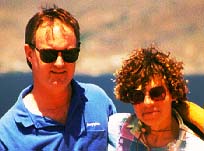 Kelly
Robinson is a most excellent sailor and very experienced as a
boat mechanic as provided by his college days. Kelly and Val own boats
and enjoy sailing the local waters as well as exploring various parts
of the world. Valerie Schwenk is an avid sailor and
very proficient at all the stations. She enjoys sailing and is a great
traveling companion. They are both a great asset on any sailing trip
and great friends for exploring the far corners of the world. No
awesome and incredible cruise should be planned without Kelly and Val. Kelly
Robinson is a most excellent sailor and very experienced as a
boat mechanic as provided by his college days. Kelly and Val own boats
and enjoy sailing the local waters as well as exploring various parts
of the world. Valerie Schwenk is an avid sailor and
very proficient at all the stations. She enjoys sailing and is a great
traveling companion. They are both a great asset on any sailing trip
and great friends for exploring the far corners of the world. No
awesome and incredible cruise should be planned without Kelly and Val. |
|
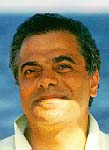 Hossein
is perhaps the most entertaining crew member and sailor in recorded
maritime history. His unique perspectives have paved the way for
modern instructional approaches. He is highly sought after by
vacationing skippers as he brings life to any party and makes each
vacation a memorable celebration. Hossein, thank you for being you. Hossein
is perhaps the most entertaining crew member and sailor in recorded
maritime history. His unique perspectives have paved the way for
modern instructional approaches. He is highly sought after by
vacationing skippers as he brings life to any party and makes each
vacation a memorable celebration. Hossein, thank you for being you. |
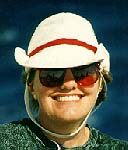 Janet Benton
is an experienced sailor and skipper. She is skilled at each of the
stations and works well both as a team player and in a command role.
She enjoys life aboard and is a most excellent travelling companion. Janet Benton
is an experienced sailor and skipper. She is skilled at each of the
stations and works well both as a team player and in a command role.
She enjoys life aboard and is a most excellent travelling companion. |
Carolanne Van Hise is a wonderful traveling and sailing companion. She enjoys life aboard and finds exploring the islands interesting and exciting. She loves the beaches, traditional villages, great restaurants, and ancient historic sites. |
| Tony Manno is new to sailing and enjoyed the sailing experience as well as exploring the islands. The Greek food was a unique delight. The culture, architecture, and local crafts were great fun and a special experience. | ||